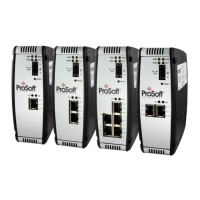PLX3x Series MBS Protocol
Ethernet and Serial Gateways User Manual
ProSoft Technology, Inc. Page 125 of 218
May 26, 2016
7.2 MBS Configuration
7.2.1 MBS Port [x]
The Modbus Port [x] sections of the PCB Tree Window, where x stands for 1, 2,
3 or 4, set the Modbus Master and slave port communication parameters and
specify the protocol-specific settings.
Configuration Parameters Common to Master and Slave
Specifies if the port will be used. If the parameter is set to No, the
port will not be used. If the parameter is set to Yes, the port will be
used.
Specifies the electrical interface for the ports.
Specifies if the port will emulate a Master or slave device.
Master - The gateway initiates Modbus commands to one or more
Modbus devices
Slave- The gateway responds to Modbus commands initiated by a
Modbus master
Specifies if the floating-point data access functionality is to be
implemented. If the float flag is set to YES, Modbus functions 3, 6,
and 16 will interpret floating-point values for registers as specified
by the two following parameters.
Specifies the first register of floating-point data. All requests with
register values greater than or equal to this value will be considered
floating-point data requests. This parameter is only used if the Float
Flag is enabled. For example, if a value of 7000 is entered, all
requests for registers 7000 and above will be considered as
floating-point data.
Specifies the start register for floating-point data in the internal
database. This parameter is used only if the Float Flag is enabled.
For example, if the Float Offset value is set to 3000 and the float
start parameter is set to 7000, data requests for register 7000 will
use the internal Modbus register 3000.
Specifies the Modbus protocol version to be used on the port.
Specifies the baud rate to be used on the port.
Parity is a simple error checking algorithm used in serial
communication. This parameter specifies the type of parity checking
to use. All devices communicating through this port must use the
same parity setting.
Specifies the number of data bits for each word used by the
protocol. All devices communicating through this port must use the
same number of data bits.
Stop bits signal the end of a character in the data stream. For most
applications, use one stop bit. For slower devices that require more
time to re-synchronize, use two stop bits.
All devices communicating through this port must use the same
number of stop bits.

